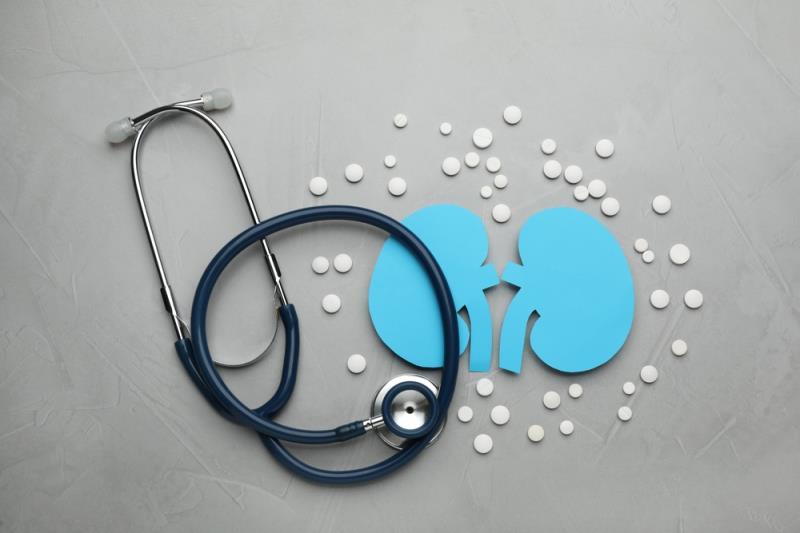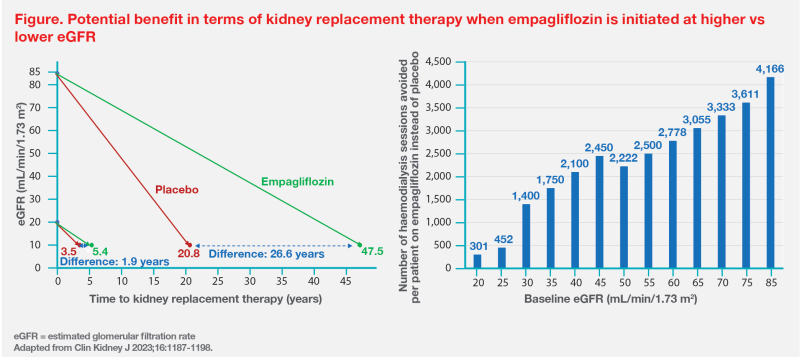Early SGLT2i initiation stalls CKD progression, may delay dialysis





Empagliflozin’s recently approved chronic kidney disease (CKD) indication expands the spectrum of patients with cardio-renal-metabolic (CRM) conditions who may benefit from treatment. At the 26th Diabetes and Cardiovascular Risk Factors – East Meets West Symposium, Dr Ted Wu, Director of the Diabetes Centre, Royal Prince Alfred Hospital in Sydney, Australia, and Honorary Professor, Shijiazhuang Diabetes Hospital, Hebei, China, highlighted empagliflozin’s benefits in CKD, type 2 diabetes (T2D) and heart failure (HF), and discussed how early initiation of empagliflozin may stall CKD progression and delay dialysis.
HK’s CKD picture
According to latest data from the Hong Kong Renal Registry, diabetes remained a leading cause of end-stage kidney disease (ESKD) and accounted for 51.5 percent of incident kidney replacement therapy (KRT) cases in 2022. [Hong Kong Med J 2024;30:332-336]
Hong Kong Chinese adults with T2D and nonalbuminuric diabetic kidney disease (DKD) are at increased risks of hospitalization for HF (HHF) and CKD progression vs those without DKD, regardless of baseline estimated glomerular filtration rate (eGFR). Notably, the risks associated with decreased eGFR alone were similar to those associated with albuminuria alone. [Am J Kid Dis 2022;80:196-206.e1]
Screen for CKD: Measure both UACR and eGFR
“These Hong Kong findings highlight the importance of measuring both albuminuria and eGFR in CKD screening,” Wu advised. “Increased urine albumin-to-creatinine ratio [UACR] and decreased eGFR are independent risk factors for cardiovascular [CV] and renal events in patients with T2D.” [J Am Soc Nephrol 2009;20:1813-1821]
“We need to proactively screen and identify CKD patients early, and provide early intervention to delay CKD progression and reduce patients’ risks of adverse CV and renal outcomes,” he emphasized. [Kidney Int 2024;105:S117-S314] “Sodium-glucose cotransporter 2 inhibitors [SGLT2i] are a great option for patients with CRM conditions, including T2D, HF/CVD and CKD.”
Empagliflozin’s benefits in broad CKD populations
Among patients with CKD enrolled in the EMPA-KIDNEY trial (n=6,609; mean age, 63.8 years; female, 33.2 percent), empagliflozin demonstrated a 28 percent relative risk reduction (RRR) in the primary composite outcome of CKD progression (ie, ESKD, a sustained decrease in eGFR to <10 mL/min/1.73 m2, a sustained decrease in eGFR of ≥40 percent from baseline, or death from renal causes) or death from CV causes vs placebo (hazard ratio [HR], 0.72; 95 percent confidence interval [CI], 0.64–0.82; p<0.001). [N Engl J Med 2023;388:117-127]
“EMPA-KIDNEY is the largest and broadest SGLT2i trial in CKD to date. Its population was also of lower risk than previous SGLT2i trials in CKD,” said Wu. “EMPA-KIDNEY included patients with albuminuria as well as those with normal to mildly increased UACR [<30 mg/g (<3 mg/mmol); 20.1 percent], whereas these types of patients were not enrolled in the previous CREDENCE and DAPA-CKD trials. Its eGFR cut-off was the lowest, at 20 mL/min/1.73 m2. At baseline, 54 percent of patients had no history of diabetes, while 73 percent had no history of CVD.” [N Engl J Med 2023;388:117-127; N Engl J Med 2019;380:2295-2306; N Engl J Med 2020;383:1436-1446]
“In lower-risk populations, it is more difficult to show positive results because the patients are farther away from the endpoints evaluated,” he continued. “Notably, EMPA-KIDNEY was stopped early, after a median follow-up of 2.0 years, due to positive primary outcome results, which were highly statistically significant.” [N Engl J Med 2023;388:117-127]
Start empagliflozin early to preserve renal function
Empagliflozin also slowed the mean annual rate of change in eGFR between 2 months and final follow-up (ie, long-term eGFR slope) vs placebo (-1.37 vs -2.75 mL/min/1.73 m2/year; between-group difference, 1.37 mL/min/1.73 m2/year) in the EMPA-KIDNEY trial. [N Engl J Med 2023;388:117-127]
“This effect was observed irrespective of baseline diabetes status and across the spectrum of UACR and eGFR, even in patients with UACR <30 mg/g [<3 mg/mmol] [-0.11 vs -0.89 mL/min/1.73 m2/year; between-group difference, 0.78 mL/min/1.73 m2/ year] or eGFR ≥45 mL/min/1.73 m2 [-1.58 vs -3.60 mL/min/1.73 m2/year; between-group difference, 2.01 mL/ min/1.73 m2/year],” Wu pointed out.
“These findings highlight the importance of starting SGLT2i early to preserve renal function in CKD patients,” he emphasized. “Extrapolated EMPA-KIDNEY data suggest that initiating empagliflozin at an eGFR of 85 mL/min/1.73 m2 would delay KRT by 26.6 years vs placebo and potentially avoid >4,000 haemodialysis [HD] sessions per patient. Starting empagliflozin at an eGFR of 20 mL/ min/1.73 m2 would delay KRT by 1.9 years vs placebo and avoid 301 HD sessions per patient.” (Figure) [Clin Kidney J 2023;16:1187-1198]

Take-home messages
“Given their proven benefits, SGLT2i should be started early in patients with CRM conditions. In CKD patients, early initiation of empagliflozin preserves renal function and may potentially delay KRT,” said Wu.
